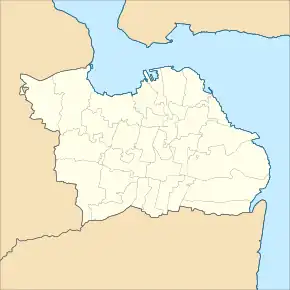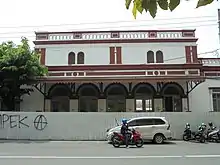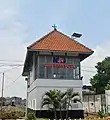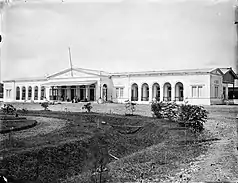Surabaya Kota Station Stasiun Surabaya Kota | |||||||||||||||||||||||||||||||||
|---|---|---|---|---|---|---|---|---|---|---|---|---|---|---|---|---|---|---|---|---|---|---|---|---|---|---|---|---|---|---|---|---|---|
 Surabaya Kota Station entrance in 2022, attached with Plaza Indo shopping center | |||||||||||||||||||||||||||||||||
| General information | |||||||||||||||||||||||||||||||||
| Other names | Semut Station | ||||||||||||||||||||||||||||||||
| Location | Jl.
Stasiun Kota no. 9, Bongkaran, Pabean Cantikan, Surabaya East Java Indonesia | ||||||||||||||||||||||||||||||||
| Coordinates | 7°14′35″S 112°44′28″E / 7.243°S 112.741°E | ||||||||||||||||||||||||||||||||
| Elevation | +4 m (13 ft) | ||||||||||||||||||||||||||||||||
| Owned by | Kereta Api Indonesia | ||||||||||||||||||||||||||||||||
| Operated by | Kereta Api Indonesia | ||||||||||||||||||||||||||||||||
| Platforms | 1 island platform 2 side platforms | ||||||||||||||||||||||||||||||||
| Tracks | 4 | ||||||||||||||||||||||||||||||||
| Connections | |||||||||||||||||||||||||||||||||
| Construction | |||||||||||||||||||||||||||||||||
| Structure type | Ground | ||||||||||||||||||||||||||||||||
| Parking | |||||||||||||||||||||||||||||||||
| Accessible | |||||||||||||||||||||||||||||||||
| Other information | |||||||||||||||||||||||||||||||||
| Station code | SB • 4510[1] | ||||||||||||||||||||||||||||||||
| Classification | Large type C[1] | ||||||||||||||||||||||||||||||||
| History | |||||||||||||||||||||||||||||||||
| Opened |
| ||||||||||||||||||||||||||||||||
| Previous names | Soerabaja Station, Soerabaia Station | ||||||||||||||||||||||||||||||||
| Services | |||||||||||||||||||||||||||||||||
| |||||||||||||||||||||||||||||||||
| Location | |||||||||||||||||||||||||||||||||
 Surabaya Kota Station Location in Surabaya | |||||||||||||||||||||||||||||||||
Surabaya Kota Station (SB) is a railway station in Bongkaran, Pabean Cantikan, Surabaya, East Java, Indonesia. The local people usually call it Semut Station.
History
Surabaya Kota Station is the first train station owned by Staatsspoorwegen (SS), a railway operator belonging to the Dutch East Indies Government. Based on its history, this station was built when the Surabaya–Malang and Pasuruan railroads were pioneered around 1870. The aim was to transport crops and plantations from the inland area of East Java, especially from Malang, to the Port of Tanjung Perak which also began to be built around that year. This building was inaugurated on 16 May 1878. With the increasing use of trains, in 1899, the old station building was finally torn down and replaced with the new building that exists today.[3]
Surabaya Kota Station became the terminal station for the best express trains of its time, starting from the Eendaagsche Express which connected Jakarta with Surabaya in the fastest time of 11 hours 30 minutes in the 1930s,[4] to the Bima night express train which reached the early 1990s brought the sleeper train.[5]
This train station was designated as a cultural heritage by the Mayor of Surabaya.[6] The station is designated as a building that must be maintained along with 60 other buildings in Surabaya. Its existence is threatened by plans to build shopping centers and shopping areas that threaten to destroy the authenticity of the station's landscape, such as the Jakarta Kota Station in Jakarta. There was even a demolition of the area which ironically involved PT Kereta Api Indonesia.
Building and layout

Located at the center of the city, the station is also the oldest railway station in Surabaya, built in 1875 and opened in 1878. The station has two buildings, the old building is located at the north-east of the newer building, whereas the new building is located at the end of the tracks. The historic old building was demolished because of mall building near the station, but the mall building process was stopped because it didn't have a building license, and the old building has been protected and chosen as one of the heritages in Surabaya.
Surabaya Kota Station has a total of twelve train lines: four tracks serve as arrivals and departures for passengers with lines 1 and 2 being straight tracks, while the remaining eight lines are buffer stops which are used as storage/parking lots for trains, except for trains. Jayakarta train, which was originally parked at this station, has now moved to Surabaya Pasarturi Station because this train has a long series of 15 trains in one train set.
The station still using mechanical signals to preserve its classical style and has two signal boxes near the exit signal. The station was very strategic, it is located near a market that is the one of the most famous markets in Surabaya, Pasar Atum, it also located near Sunan Ampel's tomb.
There are many train car shunting activities, especially at the morning and the evening when many trains are departing and arriving at the station. The station doesn't have a locomotive depot, the locomotive depot is located at Sidotopo station located at north-east of the station. Surabaya Gubeng station is located at south-east of the station about three kilometers far. Uniquely these three stations formed a triangle shaped railway, but the railway between Surabaya Kota with Surabaya Gubeng is a double tracked railway, the others are Single Tracks.
Services
Passenger trains that use this station are:
Economy Class
- Sri Tanjung to Lempuyangan and Ketapang
Commuter and Local Train
- Dhoho from and to Blitar via Kertosono
- Penataran from and to Blitar via Malang
- Tumapel from Malang
- Ekonomi Lokal Kertosono from and to Kertosono
- Komuter Surabaya–Bangil from and to Bangil
- Komuter Surabaya–Sidoarjo from and to Sidoarjo
- Komuter Surabaya–Pasuruan from and to Pasuruan
- Jenggala from and to Mojokerto
Supporting transportation
Source:[7]
| Public transportation type | Route | Destination |
|---|---|---|
| Bemo | C | Sedayu–Demak–Menjangan (via Indrapura) |
| D | RSI–Joyoboyo–Kupang–Pasar Turi–Sidorame | |
| M | Joyoboyo–Dinoyo–Undaan–Jembatan Merah Plaza (Kalimas Barat) | |
| R | Jembatan Merah Plaza (Kalimas Barat)–Kapasan–Kenjeran | |
| DA | Darmo Permai–Pasar Atom | |
| Citraland–Jembatan Merah Plaza–Krembangan | ||
| Suroboyo Bus | R2 | Rajawali–Purabaya (transfer at Tugu Pahlawan bus stop) |
Gallery
 Surabaya Kota Station when still using the old building
Surabaya Kota Station when still using the old building Surabaya Kota Station/Plaza Indo entrance in 2020
Surabaya Kota Station/Plaza Indo entrance in 2020 The station's east signal tower in 2022
The station's east signal tower in 2022
References
- 1 2 Buku Informasi Direktorat Jenderal Perkeretaapian 2014 (PDF) (in Indonesian). Archived from the original (PDF) on 1 January 2020. Retrieved 7 May 2023.
- ↑ Staatsspoorwegen (1932). Staatsspoorwegen in Nederlandsch-Indië: Jaarstatistieken over de jaren 1931 en 1932. Burgerlijke Openbare Werken.
- ↑ Staatsspoorwegen (1921–1932). Verslag der Staatsspoor-en-Tramwegen in Nederlandsch-Indië 1921-1932. Batavia: Burgerlijke Openbare Werken.
- ↑ Kop, Jan (2004). Bouwen in de Archipel: burgerlijke openbare werken in Nederlands-Indië. Walburg Press.
- ↑ Ojong, P.K. (1981). Kompasiana: esei jurnalistik tentang berbagai masalah: pers, politik, asimilasi, cendekiawan, pelayanan masyarakat, tertib hukum, kebudayaan, ekonomi, kepemimpinan, kota. Jakarta: PT. Gramedia.
- ↑ Decree of the Head of the Level II Region of Surabaya Number 188.45/251/402.1.04/1996
- ↑ "Transportasi". Surabaya City Government (in Indonesian). Archived from the original on 26 June 2018. Retrieved 7 May 2023.
External links
 Media related to Surabaya Kota Station at Wikimedia Commons
Media related to Surabaya Kota Station at Wikimedia Commons

